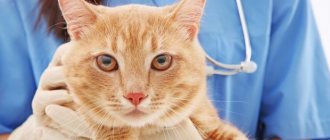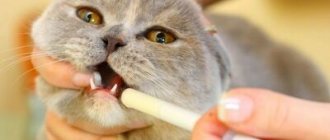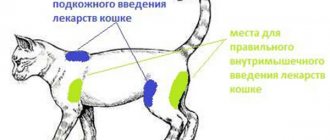Performing the procedure to remove reproductive organs in cats is not particularly difficult for a specialist. In order to minimize the risks of possible complications and pathological conditions in the animal after surgery, it is necessary to properly prepare the cat for sterilization. The main points that the pet owner must carry out independently are timely vaccination and antiparasitic treatment (destruction of ectoparasites and worms). It is also important to keep the animal on a fasting diet for at least 12 hours before surgery.
Preparing a cat for sterilization
Preparing a cat for sterilization is an important point that requires attention from the owner and veterinarian. Before performing surgery to remove reproductive organs, the veterinarian must ensure the health of the animal. Sterilization is an abdominal operation and carries some risks. The intervention is performed under general anesthesia, which entails a certain anesthetic risk.
When the body's strength is weakened, there is a high probability of complications occurring during the animal's recovery period. Timely diagnosis of problems will help to delay surgical intervention until complete recovery occurs. If the animal has chronic diseases that are not a contraindication to sterilization, then the operation is performed, but the surgeon and anesthesiologist performing it will have to take into account the specifics in order to reduce the risk of complications. Preparation for sterilization using the laparoscopic method is no different, since when performing an operation using this technique, general anesthesia is also administered.
Pros and cons of a sterilized cat
An adult unsterilized cat, deprived of mating with a male cat, often develops health problems, which leads to her short life. The decision to sterilize a pet will please owners with a number of positive aspects and reduce the risks of inflammatory diseases of the reproductive organs. Advantages of the operation:
- life expectancy will increase;
- good health will be maintained;
- the cat will stop bothering the owner with instincts that regularly wake up in the spring;
- lack of offspring that need to be accommodated;
- the cat stops marking its territory, emitting unpleasant odors.
In addition to the positive aspects, it is worth mentioning the disadvantages of the procedure:
- the appearance of seams on the animal’s body;
- the cat requires special care after surgery;
- increased appetite may arise;
- in rare cases, a hernia may develop.
© shutterstock
What the owner needs to do
First of all, the owner of the animal must carry out anthelmintic treatment of the pet before surgery. It is recommended to deworm every 3 months. Antiparasitic treatment includes not only getting rid of worms, but also lice, fleas and ticks. Before carrying out surgical manipulation, it is advisable to do treatment for worms 10-14 days in advance. It is important to note that if deworming was carried out less than one month ago, then it is not necessary to re-give the anthelmintic drug. The veterinarian who will carry out the sterilization must select the type and dosage of the drug.
An important aspect when preparing for surgery is timely vaccination. All pets must be vaccinated, regardless of whether the owner plans to sterilize or not. Carrying out abdominal surgery, which is ovariohysterectomy, in the absence of vaccinations, is associated with a high risk of infection. At least 30 calendar days must pass from the last vaccination before the animal can be operated on.
Sometimes owners refuse to vaccinate their pets. In this case, veterinary specialists at the clinic offer an injection of a special serum that allows you to develop a lasting immune response lasting 2 weeks against various infectious diseases.
The last point that the owner must fulfill is to keep the animal on a forced diet. A fasting diet involves complete food restriction for a period of 10 to 12 hours. During this period, the animal should not be given food, but water can be given. This preparation is carried out in order to minimize the risks of aspiration pneumonia in the animal after sterilization. While anesthesia is in effect, your pet may vomit. If there is food in the stomach, vomiting may cause particles to enter the respiratory system.
Feeding after sterilization
It is not recommended to feed the cat on the first day. You can drink it after 3 hours. The animal may refuse to drink. To moisten the oral mucosa, you can give a drop of water into your mouth using a pipette or a teaspoon. When recovering from anesthesia, the animal becomes nauseous and may vomit. According to the recommendations of a specialist, this is a common occurrence in a state of recovery from anesthesia. But there should not be more than 3 gag reflexes in the first hours. If vomiting does not stop, immediately return to the clinic.
Observing the owner's use of the toilet is one of the doctor's recommendations. After surgery, the cat must go to the toilet. Otherwise, a visit to the clinic is required.
For any deviation from the norm in your pet's behavior, consult your veterinarian. And if necessary, contact the clinic immediately.
What does the veterinarian check before sterilization?
Before sterilization, a veterinarian must perform an examination, including measurements of body temperature, body weight, respiration and pulse. It is also necessary to conduct a general blood test and biochemistry for the animal. This allows for timely detection of possible pathological conditions of the body that do not manifest characteristic symptoms. A biochemical blood test will allow you to assess the state of the immune system, identify inflammatory processes and other abnormalities.
Echocardiography is also important, especially if the animal is elderly, and also if it has a history of chronic diseases. Ultrasound examinations of the liver and kidneys are prescribed to check for violations of their functional characteristics. In addition to an ultrasound examination of the heart, the veterinarian may prescribe additional diagnostics in cases where the animal was street and brought to the clinic. In such cases, it is necessary not only to diagnose internal systemic diseases, but also to identify infectious diseases - panleukopenia, leukemia virus and immunodeficiency.
Examinations by a veterinarian are carried out 2-5 days before planned sterilization. The owner of the animal must take the preparation before sterilization with the utmost responsibility. This will reduce the risk of postoperative complications and other negative consequences.
What should you not do the day before? Basic Rules
Preparing the cat for surgery begins 24 hours in advance. The veterinarian will tell you in detail what and how to do at this time. The main recommendations of doctors will be:
- Trim the claws to prevent the cat from injuring itself after surgery.
- Adhere to a proper diet.
- Avoid stress.
Is it possible to feed? In no case!
We stop feeding at least 12 hours before surgery. This is necessary so that the animal does not vomit while under anesthesia and when emerging from it.
What about drinking water?
Drinking water is not allowed 5 hours before surgery. It is imperative to ensure that the cat does not have access to water during this time.
conclusions
Be sure to follow the veterinarian's recommendations!
You should strictly follow all the doctor’s recommendations. Sterilization is a full-fledged operation that violates the integrity of the animal’s skin and failure to follow instructions will entail unpredictable consequences and complications in the form of inflammatory processes and other troubles.
What additional things should you take with you?
You should take the pet's and owner's passports with you. To protect the seam from the cat’s attempts to lick it, you will need a special blanket, which will also become an obstacle to the penetration of pathogens of infectious diseases into the body weakened by the intervention. It is recommended to purchase several packages of dry and wet wipes in advance.
To avoid any difficulties, make the necessary purchases before sterilizing your cat. It is worth consulting a veterinarian.
At what age are cats spayed?
The ideal age for sterilization in cats is a relative concept. The operation can be performed at almost any age; from 6 months to 10 years it is tolerated quite easily. Older individuals may have contraindications or complications. Today, many veterinarians recommend carrying out the procedure up to a year or after the first heat. At a young age, the animal tolerates all manipulations easily and quickly adapts to the new state. He has not yet formed stable habits, which can be stronger than hormones. For example, an adult that is accustomed to marking its territory will likely continue to do so after spaying or neutering. Therefore, it is wise to act on warning and form the pet’s character and habits from a young age. It is believed that by 8 months a cat reaches sexual maturity and can bear and bear offspring up to 4 times a year. But, firstly, this is individual, for some individuals this moment comes earlier, for others later, and secondly, there are breeds in which the offspring grow for a long time and mature only by one and a half to two years. It is too early to sterilize such cats at 8 months, and it is better to select the timing of the operation together with a veterinarian. In general, the bulk of procedures occur between the ages of one and three years.
Veterinarian advice
The best time for the procedure is early morning.
It is recommended to perform the operation at this time so that when recovering from anesthesia the cat is not left to its own devices. During the day you will have to monitor the condition of the pet and stay close to it. When heading to the veterinary clinic, make sure you have the correct carrier. Best of all, with a removable top. This is necessary in order to move the animal as little as possible after the operation. You will also need a blanket or bandage after sterilization.
It is recommended to place an absorbent diaper on the bottom of the carrier or basket. Animals perceive anesthesia differently and may involuntarily wet themselves under its influence. Also, the diaper will absorb discharge from the postoperative wound, if any.
Veterinarians say that the best age for sterilization is 8-10 months. At this time, the cat’s body is fully formed and mature. The main thing is that the operation is performed before the first signs of puberty appear.
Surgery in adult cats helps prevent cancer. Therefore, if sterilization was not carried out on time, this is not a reason to completely abandon it. The main condition is that the pet must be healthy.
Transporting a cat
The animal should be transported in a special carrier. You should not carry your pet in your arms.
A towel or thick blanket should be placed inside the transport device to avoid possible injury to the animal recovering from anesthesia. There is a possibility of uncontrolled urination. To prevent an unpleasant surprise, you can lay a diaper on the bottom.
The cat should be transported in a spacious carrier. Do not roll it into a ball as the seams may come apart. If the available means of transportation is not large enough, it is better to take a sports bag or basket for this purpose, the size of which will allow the pet to stretch out.
If the cat is being operated on in the winter, it will be necessary to wrap it in a blanket or blanket after sterilization to prevent hypothermia. The temperature of the animal recovering from anesthesia is reduced.
Some people don't want to take their cat to the hospital. They can call a veterinarian to sterilize the cat at home. The disadvantage of this solution will be the increase in the cost of the procedure.
Worming
Owners often wonder whether their pet needs to be dewormed and when is the best time to do it.
The need for anthelmintic therapy depends on how long ago the pet was last treated. If the procedure was carried out no more than a month ago, you should not subject the animal’s body to additional stress. If the deworming remedy was last used a long time ago, the pet should be treated 10 days before the operation.
This measure is mandatory; animals infected with helminths are not allowed to undergo surgery.
To get rid of parasites, you can use various means. It is recommended to consult a veterinarian, who will tell you which medication is best suited in a particular case. Milbemax and Canikquantel are often used.
There are anthelmintic drugs that are applied to the animal's fur. They are considered safer for health, but their cost is much higher.
Postoperative care
Constant attention for two days (during this time the cat will fully recover from anesthesia).
Important!
If your pet has a very difficult time with the post-operative period, does not recover from anesthesia for a long time, or has foam at the mouth, then you should definitely consult a doctor!
After the clinic, the cat needs to be laid on the floor (so that it does not fall from a height) on something soft, with a diaper laid on top and covered from above.
The animal should be placed on the right side so as not to create additional stress on the heart. If a sleeping cat's eyes are open, then they need to be closed approximately twice an hour so that the cornea does not dry out.
If vomiting begins, you need to turn the muzzle on its side so that the animal does not choke.
After 3-4 hours you can offer the animal water, and after 12 - food.
It is recommended to remove the litter from the tray for several days to prevent it from getting into the wound. Otherwise, you need to completely follow the doctor’s recommendations; you may have to treat the suture site, give the animal any medications, or even give injections.
Sterilization with access along the white line of the abdomen
This is a reliable, time-tested method that is carried out, like all operations, under general anesthesia.
The cat's belly hair is shaved from the navel to the outermost pair of nipples. The surgeon makes a 1.5 to 5 cm incision along the linea alba of the abdomen. This type of operation allows you to remove the ovaries and uterus or tie the tubes. And also visually assess the condition of the internal organs.
In this case, the muscles are not affected, and only the connective tissue is cut. To prevent bleeding, the doctor cauterizes the vessels, performs all the necessary manipulations and sutures the peritoneum with suture material.
After such an operation, the pet will have to wear a special blanket for about 10 days to protect the seam from licking. Veterinarians always mention it among what is needed to sterilize a cat.
A few words about castration of cats
Castration of cats is a surgical operation in which a veterinarian surgeon removes the male gonads (testicles, testes, testicles). The operation usually takes no more than 20-40 minutes. Castration is performed under general anesthesia. Veterinarians often use combined or local anesthesia. If the clinic has an anesthesiologist, this indicates a high level of the institution.
Advice! Castration of cats can be carried out at any age, but, according to experienced breeders and leading veterinarians, the optimal age for the operation is 9-11 months. Castration at an earlier age can affect growth and development. Various serious complications may develop.
Castration can be performed in a veterinary hospital or at home. If the animal was operated on in a clinic, you can take the pet home, if there are no contraindications, approximately 30-50 minutes after castration.
Deworming regimen for an adult indoor cat that does not go outside or catch mice
Not only a street cat can become infected with worms, but also a pet that does not leave the apartment or house. Risk factors include feeding raw meat, fish, and various offal. In addition, worm eggs can enter the animal’s body from the soles of shoes or the owner’s walking clothes.
An approximate scheme for deworming a domestic cat that does not go outside:
- Fiprist flea drops.
- Caniquantel suspension or Cestal cat tablets 3-7 days after taking Fiprist.
Treatment for external and internal parasites is carried out every 6 months.
Unfortunately, a person can become infected with certain types of helminths from a cat. To minimize this risk, you need to worm your pet promptly and correctly. All family members are also recommended to take antihelminthic medications and not to forget about hygiene rules.











